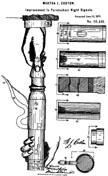| WOMEN IN TRANSPORTATION |
| Changing America's History |
| WOMEN'S HISTORY in |
| TRANSPORTATION |
|
Early Travel Maritime Navigation Bridge Construction Railroad Inventions Automobile Inventions Aviation Pioneers Bus Operators Rosie The Riveter Pedestrian & Urban Design Chemical Engineering Administration Space Travel
Websites Reference Materials (wmntrans2.pdf 146KB)
Acknowledgements
Summer Transportation Internship Program for Diverse Groups
Garrett A. Morgan Technology and Transportation Futures Program is an initiative of the U.S. DOT to encourage students from kindergarten to adulthood, to recognize the opportunities for achievement and service in transportation. The inspiration for the program came from the work of Garrett A. Morgan, an African American who was granted a patent for the first automated traffic signal in 1923. For more Information
Write to us at:
Or e-mail at:
|
American women have played important roles in improving how we travel for more than 170 years.
In the mid 19th century, Americans traveled primarily by walking, horse and carriage, canal boats, and steam ships. In 1825, Rebecca Lukens took charge of the Brandywine Iron Works.
 Martha J. Coston developed a maritime navigation system using pyrotechnics. These burning flares assisted the U.S. Navy and the navies of many European countries to communicate with and rescue shipwreck victims. Martha J. Coston developed a maritime navigation system using pyrotechnics. These burning flares assisted the U.S. Navy and the navies of many European countries to communicate with and rescue shipwreck victims.
Soon, the era of the "iron horse" was upon us. During the 1800s, several women inventors made important contributions to improving safety and reducing noise pollution from trains. Early inventions included Mary I. Riggin's railway crossing gate; Eliza Murfey's lubricating systems for railroad car axles to reduce derailments; and Mary Walton's noise reduction system for elevated railroads in New York City. At the beginning of the 20th century, the horseless carriage was causing a stir. The first American automobile, the Duryea, was developed in 1893. In 1903, Mary Anderson invented a windshield wiper to improve safety while driving in rain, sleet, and snow. By 1923, more than 175 patents were granted to women for inventions related to automobiles, traffic signals, and turn indicators.
By the late 1970s and early 1980s, women were taking greater leadership roles in transportation. Elizabeth Dole was appointed Secretary of Transportation in 1983. In the same year, Carmen Turner became the General Manager of the Washington Metropolitan Area Transit Authority.
Where Do You Transportation is critical to the economy of the United States. Our transportation systems must be effective and efficient. Not only must we maintain the systems already in place, but we must be willing to take chances and explore new ideas that move our nation forward into the next century. Your creativity and hard work will be part of our future. Women are an essential part of today's labor force, yet women are still underrepresented in the technology areas. There are more than 60 million women in the labor force today, yet women make up only 8 percent of engineers, 18 percent of engineering technicians, and 30 percent of natural scientists (which includes chemists and geologists). Today, our marine navigation systems are far more accurate and therefore provide more safety than the signals Mary Coston invented in 1859. Marine and aviation navigation now use Global Positioning Satellite (GPS) systems. GPS technology combined with geographic information systems are part of the Intelligent Transportation Systems being built today. Despite railroad crossing gates designed from the late 1800s onward, safety at railroad crossings continues to be an issue today. Air quality was on Mary Walton's mind when she invented a way to reduce the emissions from locomotives using an invention she patented in 1879 for smoke stacks. Air quality is still on the American agenda, with the U.S. Department of Transportation and the Environmental Protection Agency working together to reduce pollution from mobile sources. Now that the automobile is the primary mode of transportation for most Americans, automobile manufacturers must design and build cars that meet national and state air quality and safety standards and appeal to American drivers. Women hold important positions with automobile manufacturers and continue to be strong advocates for safety in automobile design. Women working as chemical engineers, structural engineers, highway engineers, planners, geographers, and computer analysts all contribute to our mobility today. Our highways and bridges are critical to the movement of both people and goods. In the United States today, there are nearly four million miles of roads and more than 576,000 bridges. Although we now rely mainly on private vehicles such as cars and light trucks, airplane travel is no longer limited to adventurers like Harriet Quimby, Bessie Coleman, and Amelia Earhart. Yet, women still make up a verysmall proportion (6 percent) of today's pilots. Today, Americans travel more than ever before. We walk, bike, drive, and take buses, trains, and planes. We can take strength from the efforts of the women who fought discrimination and pioneered many different aspects of transportation over the last 150 years. We can be inspired by their success. |
||||
|
This website is an electronic version of Publication No. FHWA-PL-98-016 HPM-40/5-98(20M)E and Publication No. FHWA-PL-98-017 HPM-40/5-98(20M)E |